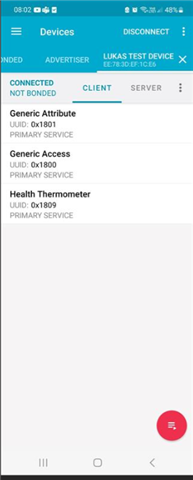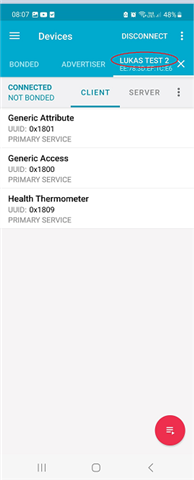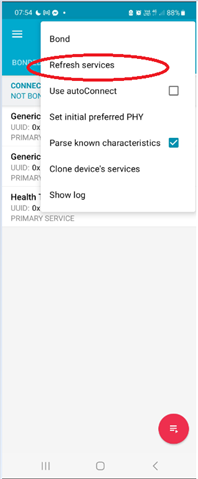Hello. I have been reading quite a bit about the BLE technology and after some time I have decided to start some hands on practise myself.
I use:
- NCS v2.5.0
- nRF52840DK nRF52840 development board
I have initially started with peripheral_ht sample project that is available in C:\ncs\v2.5.0\samples\bluetooth.
I have stripped down this project as much as I could and I got left with the very basic BLE code that only does some basic advertising. See the full source code:
/* main.c - Application main entry point */ /* * Copyright (c) 2019 Aaron Tsui <[email protected]> * * SPDX-License-Identifier: Apache-2.0 */ #include <zephyr/types.h> #include <stddef.h> #include <string.h> #include <errno.h> #include <zephyr/sys/printk.h> #include <zephyr/sys/byteorder.h> #include <zephyr/kernel.h> #include <zephyr/bluetooth/bluetooth.h> #include <zephyr/bluetooth/hci.h> #include <zephyr/bluetooth/conn.h> #include <zephyr/bluetooth/uuid.h> #include <zephyr/bluetooth/gatt.h> #define LOG_LEVEL CONFIG_LOG_DEFAULT_LEVEL #include <zephyr/logging/log.h> LOG_MODULE_REGISTER(main); static const struct bt_data ad[] = { BT_DATA_BYTES(BT_DATA_FLAGS, (BT_LE_AD_GENERAL | BT_LE_AD_NO_BREDR))}; static void connected(struct bt_conn *conn, uint8_t err) { if (err) { LOG_ERR("Connection failed (err 0x%02x)\n", err); } else { LOG_INF("Connected\n"); } } static void disconnected(struct bt_conn *conn, uint8_t reason) { LOG_ERR("Disconnected (reason 0x%02x)\n", reason); } static void bt_ready(void) { int err; LOG_INF("Bluetooth initialized\n"); err = bt_le_adv_start(BT_LE_ADV_CONN_NAME, ad, ARRAY_SIZE(ad), NULL, 0); if (err) { LOG_ERR("Advertising failed to start (err %d)\n", err); return; } LOG_INF("Advertising successfully started\n"); } int main(void) { int err; err = bt_enable(NULL); if (err) { LOG_INF("Bluetooth init failed (err %d)\n", err); return 0; } bt_ready(); /* Implement indicate. At the moment there is no suitable way * of starting delayed work so we do it here */ while (1) { k_sleep(K_SECONDS(1)); LOG_INF("hello world \n"); } return 0; }
and my prj.conf:
CONFIG_BT=y CONFIG_LOG=y CONFIG_LOG_MODE_IMMEDIATE=y CONFIG_BT_PERIPHERAL=y CONFIG_BT_DEVICE_NAME="Lukas test device" CONFIG_CBPRINTF_FP_SUPPORT=y
After experimenting with it for a few hours, I have found 2 critical issues:
1. Modifying advertisement data and reflashing the device does not really update the advertisement packets.
For example, from the code above, you can see that my current advertisement data looks as following:
static const struct bt_data ad[] = {
BT_DATA_BYTES(BT_DATA_FLAGS, (BT_LE_AD_GENERAL | BT_LE_AD_NO_BREDR))};
But when I flash the device and monitor it through my Android phone (nRF Connect app), I can see that there are 3 services being advertised. I cannot wrap my head around why Health Thermometer is being advertised since I do not have anything in my code related to Health Thermometer. See image I have captured on my phone:

Additionally, I have tried to update my advertisment data by adding something to it. I have added Battery Service:
static const struct bt_data ad[] = {
BT_DATA_BYTES(BT_DATA_FLAGS, (BT_LE_AD_GENERAL | BT_LE_AD_NO_BREDR)),
BT_DATA_BYTES(BT_DATA_UUID16_ALL, BT_UUID_16_ENCODE(BT_UUID_BAS_VAL))};
To ensure that I have flashed the device correctly, I have also changed BT device name:

After reflashing the device, I can confirm that BT device name is changed but the advertisement has still not updated:

2. Cannot debug the code using breakpoints
Out of curiosity, I have tried to step through the code using breakpoints. I have noticed that after
err = bt_le_adv_start(BT_LE_ADV_CONN_NAME, ad, ARRAY_SIZE(ad), NULL, 0);

*** Booting nRF Connect SDK v2.5.0 ***
[00:00:00.003,875] [1B][0m<inf> bt_sdc_hci_driver: SoftDevice Controller build revision:
c5 93 ba a9 14 4d 8d 05 30 4e 9b 92 d7 71 1e e8 |.....M.. 0N...q..
aa 02 50 3c |..P< [1B][0m
[00:00:00.035,308] [1B][0m<inf> bt_hci_core: HW Platform: Nordic Semiconductor (0x0002)[1B][0m
[00:00:00.043,395] [1B][0m<inf> bt_hci_core: HW Variant: nRF52x (0x0002)[1B][0m
[00:00:00.050,170] [1B][0m<inf> bt_hci_core: Firmware: Standard Bluetooth controller (0x00) Version 197.47763 Build 2370639017[1B][0m
[00:00:00.062,530] [1B][0m<inf> bt_hci_core: Identity: EE:78:3D:EF:1C:E6 (random)[1B][0m
[00:00:00.070,098] [1B][0m<inf> bt_hci_core: HCI: version 5.4 (0x0d) revision 0x1102, manufacturer 0x0059[1B][0m
[00:00:00.079,803] [1B][0m<inf> bt_hci_core: LMP: version 5.4 (0x0d) subver 0x1102[1B][0m
[00:00:01.712,036] [1B][0m<inf> main: Bluetooth initialized
[1B][0m
[00:00:06.998,870] [1B][1;31m<err> mpsl_init: MPSL ASSERT: 112, 2185[1B][0m
[00:00:07.020,141] [1B][1;31m<err> os: ***** HARD FAULT *****[1B][0m
[00:00:07.040,740] [1B][1;31m<err> os: Fault escalation (see below)[1B][0m
[00:00:07.062,042] [1B][1;31m<err> os: ARCH_EXCEPT with reason 3
[1B][0m
[00:00:07.083,007] [1B][1;31m<err> os: r0/a1: 0x00000003 r1/a2: 0x00000000 r2/a3: 0x00000000[1B][0m
[00:00:07.106,811] [1B][1;31m<err> os: r3/a4: 0x20002354 r12/ip: 0x00000000 r14/lr: 0x0002051f[1B][0m
[00:00:07.130,645] [1B][1;31m<err> os: xpsr: 0x41000018[1B][0m
[00:00:07.150,909] [1B][1;31m<err> os: Faulting instruction address (r15/pc): 0x000198c2[1B][0m
[00:00:07.173,950] [1B][1;31m<err> os: >>> ZEPHYR FATAL ERROR 3: Kernel oops on CPU 0[1B][0m
[00:00:07.196,685] [1B][1;31m<err> os: Fault during interrupt handling
[1B][0m
[00:00:07.218,200] [1B][1;31m<err> os: Current thread: 0x200021e0 (unknown)[1B][0m
[00:00:07.259,918] [1B][1;31m<err> fatal_error: Resetting system[1B][0m
*** Booting nRF Connect SDK v2.5.0 ***
[00:00:00.003,875] [1B][0m<inf> bt_sdc_hci_driver: SoftDevice Controller build revision:
c5 93 ba a9 14 4d 8d 05 30 4e 9b 92 d7 71 1e e8 |.....M.. 0N...q..
aa 02 50 3c |..P< [1B][0m
[00:00:00.035,308] [1B][0m<inf> bt_hci_core: HW Platform: Nordic Semiconductor (0x0002)[1B][0m
[00:00:00.043,395] [1B][0m<inf> bt_hci_core: HW Variant: nRF52x (0x0002)[1B][0m
[00:00:00.050,140] [1B][0m<inf> bt_hci_core: Firmware: Standard Bluetooth controller (0x00) Version 197.47763 Build 2370639017[1B][0m
[00:00:00.062,530] [1B][0m<inf> bt_hci_core: Identity: EE:78:3D:EF:1C:E6 (random)[1B][0m
[00:00:00.070,098] [1B][0m<inf> bt_hci_core: HCI: version 5.4 (0x0d) revision 0x1102, manufacturer 0x0059[1B][0m
[00:00:00.079,833] [1B][0m<inf> bt_hci_core: LMP: version 5.4 (0x0d) subver 0x1102[1B][0m




